PRAY FOR MBEYA
Geography & History
Surrounded by mountains in southwest Tanzania, Mbeya Region spans 62,420 square kilometers (24,100 sq. mi) and is made up of 8 districts. The capital of the region is Mbeya City and local tribes for the Mbeya region include: Nyakyusa, Ndali, Nyiha, Nyamwanga, Bungu and Safwa. Colloquial Swahili is the main language and English is widely taught in the schools.
Following the 1905 gold rush, Mbeya was founded as a gold mining town in the 1920s. The TAZARA railway later attracted farming migrants and small entrepreneurs to the area. Mbeya and its district was administered by the British until 1961.
The city is well connected with an all-weather road that forms part of the "Great North Road" running from Cape Town to Alexandria. Average highs and lows during August are 22/9 Celsius and 72/48 Fahrenheit. Mbeya City is a growing metropolis and business centre for the southern regions and the neighbouring countries of Malawi, Zambia and Congo. The economy relies heavily on agriculture, but also depends on mining, trade, and tourism as well.
Places of Interest in Mbeya Region- Mbozi meteorite, Kitulo National Park, Ruaha National Park, Lake Nyasa, Mwalalo Water Falls, and the Sokoine Stadium, home of the Mbeya City Council Football Club.
Overview of Tanzania
“Unlike in other African countries, most people identify themselves as Tanzanian first and foremost. From a young age, Tanzanian children are taught how to be polite and respectful. They will normally greet their elders with the phrase shikamoo, which literally translates as ‘I hold your feet’.
Tanzania’s population includes more than 120 different indigenous African peoples, most of whom are clustered into larger groupings. Today the majority of Tanzanians are of Bantu descent. The population for Tanzania is approximately 50 million.
Tanzania is an East African country known for its vast wilderness areas. Tanzania, officially the "United Republic of Tanzania," is situated just south of the Equator, within the African Great Lakes region and formed as a sovereign state in 1964, through the union of the theretofore separate states of Tanganyika and Zanzibar.
Housing- Across rural areas of Tanzania, houses are often traditionally built of stone or earthen construction, with roofs of thatch or corrugated iron. The shape varies by region. On the shores of Lake Victoria, traditional houses are beehive-shaped. In other regions, they’re rectangular. They’re usually surrounded by a smallholding or shamba, where families plant crops and keep livestock such as chickens or goats.





